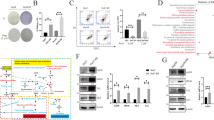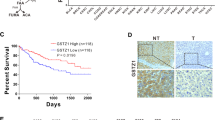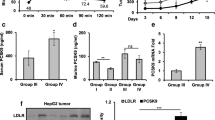Abstract
Objective
Due to the tissue specificity of the liver, long-term exposure to a high concentration of 27-hydroxycholesterol (27HC) is a special characteristic of the tumour microenvironment in hepatocellular carcinoma (HCC). However, what occurs after HCC cells are long-term exposure to 27HC and the molecular mechanisms involved remain largely unexamined.
Methods
A long-term 27HC-treated HepG2 cell line and the xenografts in nude mice were used as experimental models. Molecular mechanisms were investigated using bioinformatics analysis and molecular biological experiments.
Results
Here, we found that by inducing an increase in oxidative stress signalling, 27HC activated glucose-regulated protein 75 (GRP75). On the one hand, GRP75 resulted in a change in the redox balance by regulating ROS generation and antioxidant system activity via affecting MMP, NRF2, HO-1, and NQO1 levels. On the other hand, GRP75 modified the metabolic reprogramming process by regulating key factors (HIF-1α, p-Akt, and c-myc) and glucose uptake, facilitating HCC cell growth in the inhospitable microenvironment. These two factors caused HCC cells to resist 27HC-induced cytotoxicity and attain multidrug resistance (MDR).
Conclusions
Our present study not only identified 27HC, a characteristic component of the neoplastic microenvironment of HCC that causes MDR via GRP75 to regulate the redox balance and metabolic reprogramming, but also revealed that targeted intervention by the “switch”-like molecule GRP75 could reverse the effect of 27HC from cancer promotion to cytotoxicity in HCC, suggesting a new strategy for specific intervention of HCC.









Similar content being viewed by others
Data availability
Not applicable.
References
Ashburner M, Ball CA, Blake JA, Botstein D, Butler H, Cherry JM, et al. Gene ontology: tool for the unification of biology. The Gene Ontology Consortium. Nat Genet. 2000;25(1):25–9. https://doi.org/10.1038/75556.
Bray F, Ferlay J, Soerjomataram I, Siegel RL, Torre LA, Jemal A. Global cancer statistics 2018: GLOBOCAN estimates of incidence and mortality worldwide for 36 cancers in 185 countries. CA Cancer J Clin. 2018;68(6):394–424. https://doi.org/10.3322/caac.21492.
Chen L, Zhang L, Xian G, Lv Y, Lin Y, Wang Y. 25-Hydroxycholesterol promotes migration and invasion of lung adenocarcinoma cells. Biochem Biophys Res Commun. 2017;484(4):857–63. https://doi.org/10.1016/j.bbrc.2017.02.003.
Cucchetti A, Zhong J, Berhane S, Toyoda H, Shi K, Tada T, et al. The chances of hepatic resection curing hepatocellular carcinoma. J Hepatol. 2020;72(4):711–7. https://doi.org/10.1016/j.jhep.2019.11.016.
Dias IHK, Milic I, Heiss C, Ademowo OS, Polidori MC, Devitt A, et al. Inflammation, lipid (per)oxidation, and redox regulation. Antioxid Redox Signal. 2020;33:166–90. https://doi.org/10.1089/ars.2020.8022.
Eggert T, Greten TF. Tumor regulation of the tissue environment in the liver. Pharmacol Ther. 2017;173:47–57. https://doi.org/10.1016/j.pharmthera.2017.02.005.
Hiramitsu S, Ishikawa T, Lee WR, Khan T, Crumbley C, Khwaja N, et al. Estrogen receptor beta-mediated modulation of lung cancer cell proliferation by 27-hydroxycholesterol. Front Endocrinol. 2018;9:470. https://doi.org/10.3389/fendo.2018.00470.
Honrath B, Culmsee C, Dolga AM. One protein, different cell fate: the differential outcome of depleting GRP75 during oxidative stress in neurons. Cell Death Dis. 2018;9(2):32. https://doi.org/10.1038/s41419-017-0148-7.
Honrath B, Metz I, Bendridi N, Rieusset J, Culmsee C, Dolga AM. Glucose-regulated protein 75 determines ER-mitochondrial coupling and sensitivity to oxidative stress in neuronal cells. Cell Death Dis. 2017;3:17076. https://doi.org/10.1038/cddiscovery.2017.76.
Hou S, Shan M, Gao C, Feng X, Yang Y, Zhang R, et al. PCDHGB7 Increases Chemosensitivity to carboplatin by inhibiting HSPA9 via inducing apoptosis in breast cancer. Dis Markers. 2019;2019:6131548–11. https://doi.org/10.1155/2019/6131548.
Hu Y, Yang L, Yang Y, Han Y, Wang Y, Liu W, et al. Oncogenic role of mortalin contributes to ovarian tumorigenesis by activating the MAPK-ERK pathway. J Cell Mol Med. 2016;20(11):2111–21. https://doi.org/10.1111/jcmm.12905.
Hyun MH, Lee YS, Kim JH, Lee CU, Jung YK, Seo YS, et al. Hepatic resection compared to chemoembolization in intermediate- to advanced-stage hepatocellular carcinoma: a meta-analysis of high-quality studies. Hepatology. 2018;68(3):977–93. https://doi.org/10.1002/hep.29883.
Juhling F, Hamdane N, Crouchet E, Li S, El Saghire H, Mukherji A, et al. Targeting clinical epigenetic reprogramming for chemoprevention of metabolic and viral hepatocellular carcinoma. Gut. 2020;70:157–69. https://doi.org/10.1136/gutjnl-2019-318918.
Kanehisa M, Furumichi M, Tanabe M, Sato Y, Morishima K. KEGG: new perspectives on genomes, pathways, diseases and drugs. Nucleic Acids Res. 2017;45(D1):D353–D61. https://doi.org/10.1093/nar/gkw1092.
Kuczynski EA, Yin M, Bar-Zion A, Lee CR, Butz H, Man S, et al. Co-option of liver vessels and not sprouting angiogenesis drives acquired sorafenib resistance in hepatocellular carcinoma. J Natl Cancer Inst. 2016;108(8). https://doi.org/10.1093/jnci/djw030.
Kuzu OF, Noory MA, Robertson GP. The role of cholesterol in cancer. Cancer Res. 2016;76(8):2063–70. https://doi.org/10.1158/0008-5472.CAN-15-2613.
Le Cornet C, Walter B, Sookthai D, Johnson TS, Kuhn T, Herpel E, et al. Circulating 27-hydroxycholesterol and breast cancer tissue expression of CYP27A1, CYP7B1, LXR-beta, and ERbeta: results from the EPIC-Heidelberg cohort. Breast Cancer Res. 2020;22(1):23. https://doi.org/10.1186/s13058-020-1253-6.
Lemaire-Ewing S, Prunet C, Montange T, Vejux A, Berthier A, Bessede G, et al. Comparison of the cytotoxic, pro-oxidant and pro-inflammatory characteristics of different oxysterols. Cell Biol Toxicol. 2005;21(2):97–114. https://doi.org/10.1007/s10565-005-0141-2.
Licarete E, Rauca VF, Luput L, Drotar D, Stejerean I, Patras L, et al. Overcoming intrinsic doxorubicin resistance in melanoma by anti-angiogenic and anti-metastatic effects of liposomal prednisolone phosphate on tumor microenvironment. Int J Mol Sci. 2020;21(8). https://doi.org/10.3390/ijms21082968.
Liu Y, Liu W, Song XD, Zuo J. Effect of GRP75/mthsp70/PBP74/mortalin overexpression on intracellular ATP level, mitochondrial membrane potential and ROS accumulation following glucose deprivation in PC12 cells. Mol Cell Biochem. 2005;268(1-2):45–51. https://doi.org/10.1007/s11010-005-2996-1.
Liu Y, Lu LL, Wen D, Liu DL, Dong LL, Gao DM, et al. MiR-612 regulates invadopodia of hepatocellular carcinoma by HADHA-mediated lipid reprogramming. J Hematol Oncol. 2020;13(1):12. https://doi.org/10.1186/s13045-019-0841-3.
Lu M, Hu XH, Li Q, Xiong Y, Hu GJ, Xu JJ, et al. A specific cholesterol metabolic pathway is established in a subset of HCCs for tumor growth. J Mol Cell Biol. 2013;5(6):404–15. https://doi.org/10.1093/jmcb/mjt039.
Lu WJ, Lee NP, Kaul SC, Lan F, Poon RT, Wadhwa R, et al. Induction of mutant p53-dependent apoptosis in human hepatocellular carcinoma by targeting stress protein mortalin. Int J Cancer. 2011;129(8):1806–14. https://doi.org/10.1002/ijc.25857.
Nault JC, Zucman-Rossi J. Genetics of hepatobiliary carcinogenesis. Semin Liver Dis. 2011;31(2):173–87. https://doi.org/10.1055/s-0031-1276646.
Nelson ER, Wardell SE, Jasper JS, Park S, Suchindran S, Howe MK, et al. 27-Hydroxycholesterol links hypercholesterolemia and breast cancer pathophysiology. Science. 2013;342(6162):1094–8. https://doi.org/10.1126/science.1241908.
Park JW, Kim YJ, Kim DY, Bae SH, Paik SW, Lee YJ, et al. Sorafenib with or without concurrent transarterial chemoembolization in patients with advanced hepatocellular carcinoma: the phase III STAH trial. J Hepatol. 2019;70(4):684–91. https://doi.org/10.1016/j.jhep.2018.11.029.
Pascut D, Pratama MY, Vo NVT, Masadah R, Tiribelli C. The crosstalk between tumor cells and the microenvironment in hepatocellular carcinoma: the role of exosomal microRNAs and their clinical implications. Cancers (Basel). 2020;12(4). https://doi.org/10.3390/cancers12040823.
Poli G, Biasi F, Leonarduzzi G. Oxysterols in the pathogenesis of major chronic diseases. Redox Biol. 2013;1:125–30. https://doi.org/10.1016/j.redox.2012.12.001.
Qiu Y, Dai Y, Zhang C, Yang Y, Jin M, Shan W, et al. Arsenic trioxide reverses the chemoresistance in hepatocellular carcinoma: a targeted intervention of 14-3-3eta/NF-kappaB feedback loop. J Exp Clin Cancer Res. 2018;37(1):321. https://doi.org/10.1186/s13046-018-1005-y.
Rozenberg P, Ziporen L, Gancz D, Saar-Ray M, Fishelson Z. Cooperation between Hsp90 and mortalin/GRP75 in resistance to cell death induced by complement C5b-9. Cell Death Dis. 2018;9(2):150. https://doi.org/10.1038/s41419-017-0240-z.
Russell DW. Fifty years of advances in bile acid synthesis and metabolism. J Lipid Res. 2009;50(Suppl):S120–5. https://doi.org/10.1194/jlr.R800026-JLR200.
Ryu J, Kaul Z, Yoon AR, Liu Y, Yaguchi T, Na Y, et al. Identification and functional characterization of nuclear mortalin in human carcinogenesis. J Biol Chem. 2014;289(36):24832–44. https://doi.org/10.1074/jbc.M114.565929.
Salonurmi T, Nabil H, Ronkainen J, Hyotylainen T, Hautajarvi H, Savolainen MJ, et al. 4beta-Hydroxycholesterol signals from the liver to regulate peripheral cholesterol transporters. Front Pharmacol. 2020;11:361. https://doi.org/10.3389/fphar.2020.00361.
Sari AN, Bhargava P, Dhanjal JK, Putri JF, Radhakrishnan N, Shefrin S, et al. Combination of withaferin-A and CAPE provides superior anticancer potency: bioinformatics and experimental evidence to their molecular targets and mechanism of action. Cancers (Basel). 2020;12(5). https://doi.org/10.3390/cancers12051160.
Sarosiek KA, Ni Chonghaile T, Letai A. Mitochondria: gatekeepers of response to chemotherapy. Trends Cell Biol. 2013;23(12):612–9. https://doi.org/10.1016/j.tcb.2013.08.003.
Shen Z, Zhu D, Liu J, Chen J, Liu Y, Hu C, et al. 27-Hydroxycholesterol induces invasion and migration of breast cancer cells by increasing MMP9 and generating EMT through activation of STAT-3. Environ Toxicol Pharmacol. 2017;51:1–8. https://doi.org/10.1016/j.etap.2017.02.001.
Srivastava S, Vishwanathan V, Birje A, Sinha D, D’Silva P. Evolving paradigms on the interplay of mitochondrial Hsp70 chaperone system in cell survival and senescence. Crit Rev Biochem Mol Biol. 2019;54(6):517–36. https://doi.org/10.1080/10409238.2020.1718062.
Takaki Y, Mizuochi T, Takei H, Eda K, Konishi KI, Ishihara J, et al. Urinary and serum oxysterols in children: developmental pattern and potential biomarker for pediatric liver disease. Sci Rep. 2020;10(1):6752. https://doi.org/10.1038/s41598-020-63758-2.
Tovar V, Cornella H, Moeini A, Vidal S, Hoshida Y, Sia D, et al. Tumour initiating cells and IGF/FGF signalling contribute to sorafenib resistance in hepatocellular carcinoma. Gut. 2017;66(3):530–40. https://doi.org/10.1136/gutjnl-2015-309501.
Vurusaner B, Gamba P, Gargiulo S, Testa G, Staurenghi E, Leonarduzzi G, et al. Nrf2 antioxidant defense is involved in survival signaling elicited by 27-hydroxycholesterol in human promonocytic cells. Free Radic Biol Med. 2016;91:93–104. https://doi.org/10.1016/j.freeradbiomed.2015.12.007.
Vurusaner B, Gamba P, Testa G, Gargiulo S, Biasi F, Zerbinati C, et al. Survival signaling elicited by 27-hydroxycholesterol through the combined modulation of cellular redox state and ERK/Akt phosphorylation. Free Radic Biol Med. 2014;77:376–85. https://doi.org/10.1016/j.freeradbiomed.2014.07.026.
Wadhwa R, Taira K, Kaul SC. An Hsp70 family chaperone, mortalin/mthsp70/PBP74/Grp75: what, when, and where? Cell Stress Chaperones. 2002;7(3):309–16.
Wang YJ, Bian Y, Luo J, Lu M, Xiong Y, Guo SY, et al. Cholesterol and fatty acids regulate cysteine ubiquitylation of ACAT2 through competitive oxidation. Nat Cell Biol. 2017;19(7):808–19. https://doi.org/10.1038/ncb3551.
Xu H, Guan N, Ren YL, Wei QJ, Tao YH, Yang GS, et al. IP3R-Grp75-VDAC1-MCU calcium regulation axis antagonists protect podocytes from apoptosis and decrease proteinuria in an Adriamycin nephropathy rat model. BMC Nephrol. 2018;19(1):140. https://doi.org/10.1186/s12882-018-0940-3.
Yan H, Dong X, Zhong X, Ye J, Zhou Y, Yang X, et al. Inhibitions of epithelial to mesenchymal transition and cancer stem cells-like properties are involved in miR-148a-mediated anti-metastasis of hepatocellular carcinoma. Mol Carcinog. 2014;53(12):960–9. https://doi.org/10.1002/mc.22064.
Ye LY, Chen W, Bai XL, Xu XY, Zhang Q, Xia XF, et al. Hypoxia-induced epithelial-to-mesenchymal transition in hepatocellular carcinoma induces an immunosuppressive tumor microenvironment to promote metastasis. Cancer Res. 2016;76(4):818–30. https://doi.org/10.1158/0008-5472.CAN-15-0977.
Yen JH, Wu PS, Chen SF, Wu MJ. Fisetin protects PC12 cells from tunicamycin-mediated cell death via reactive oxygen species scavenging and modulation of Nrf2-driven gene expression, SIRT1 and MAPK signaling in PC12 cells. Int J Mol Sci. 2017;18(4). https://doi.org/10.3390/ijms18040852.
Zhu D, Shen Z, Liu J, Chen J, Liu Y, Hu C, et al. The ROS-mediated activation of STAT-3/VEGF signaling is involved in the 27-hydroxycholesterol-induced angiogenesis in human breast cancer cells. Toxicol Lett. 2016;264:79–86. https://doi.org/10.1016/j.toxlet.2016.11.006.
Funding
This work was supported by the National Natural Science Foundation of China (81961160708 to YL; 81973096 to LL); the Natural Science Foundation of Jiangsu Province (BK20181155 to LT); the “Qing Lan” Project Funded by Jiangsu Province (to YL); the Project Funded by Jiangsu Postgraduate Research and Innovation Plan (SJCX19-0316 to MJ); the Project Funded by Jiangsu Collaborative Innovation Center For Cancer Personalized Medicine (JX21817902/006 to YL); and the Major Projects of Science and Technology Development Fund of Nanjing Medical University (NMUD2019008 to YL).
Author information
Authors and Affiliations
Contributions
YL, LL, and LT conceived the research. MJ, YD, and YJ performed cell experiments. YY and ZZ performed the in vivo experiments. RC, LW, and HY carried out the bioinformatics analysis. YZ and YY analyzed the data. MJ, YD, and YY drafted the manuscript. All the authors have read and approved the final version of the manuscript. MJ, YY, and YD contributed equally to this work.
Corresponding authors
Ethics declarations
Ethics approval
Not applicable
Consent to participate
Not applicable
Consent for publication
Not applicable
Competing interests
The authors declare no competing interests.
Additional information
Publisher’s note
Springer Nature remains neutral with regard to jurisdictional claims in published maps and institutional affiliations.
Highlights
1. Long-term exposure to 27HC caused MDR in HCC cells.
2. Redox balance and metabolic reprogramming were two important neoplastic biological behaviours in 27HC-induced MDR.
3. Identified GRP75 as a “switch”-like molecule, facilitating 27HC-induced MDR.
4. Knockdown of GRP75 reversed the roles of 27HC from cancer promotion to HCC cytotoxicity, suggesting a new idea of HCC intervention.
Supplementary information
ESM 1
(DOCX 2506 kb)
Rights and permissions
About this article
Cite this article
Jin, M., Yang, Y., Dai, Y. et al. 27-Hydroxycholesterol is a specific factor in the neoplastic microenvironment of HCC that causes MDR via GRP75 regulation of the redox balance and metabolic reprogramming. Cell Biol Toxicol 38, 311–324 (2022). https://doi.org/10.1007/s10565-021-09607-y
Received:
Accepted:
Published:
Issue Date:
DOI: https://doi.org/10.1007/s10565-021-09607-y




